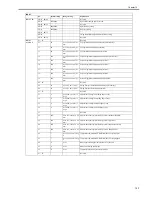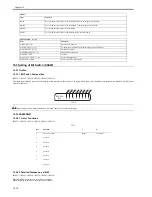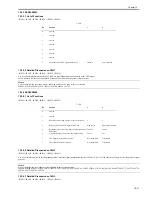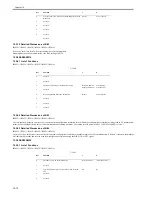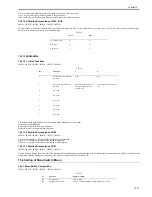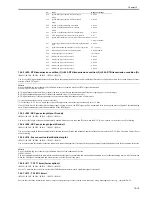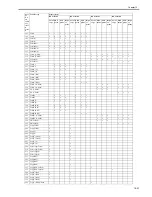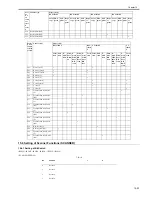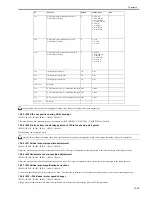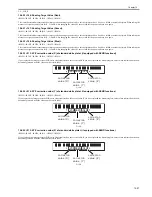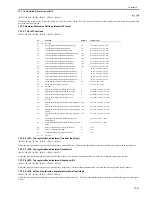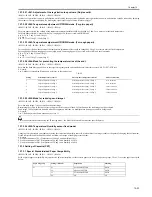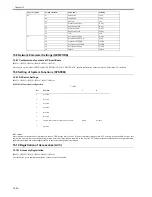
Chapter 15
15-19
15.5.2 <002: RTN transmission condition (1)><003: RTN transmission condition (2)><004: RTN transmission condition (3)>
0017-6100
iR2022i / iR2025 / iR2030 / iR2018 / iR2022 / iR2018i
Use it to set RTN signal transmission conditions. Raise these parameters for more lenient conditions if errors occur frequently at time of reception because of trans-
mission of the RTN signal.
Memo:
Any of the following error codes may be indicated at time of reception because of RTN signal transmission
##0104, ##0107, ##0114, ##0201
RTN signal transmission condition (1) affects the ratio of error lines to the total number of lines per single page of received images.
RTN signal transmission condition (2) affects the standard value (*2) of burst errors (*1).
RTN signal condition (3) affects the number of errors not reaching the standard value of burst errors.
*1: transmission error occurring cover several lines.
*2: for instance, if '15' is set, a single burst error will represent an error occurring continuously cover 15 lines.
If any of these lines is detected while an image signal is being received, the RTN signal will be transmitted after receiving the protocol signal of the transmitting
party. Higher parameters restrict the transmission of the RTN signal.
15.5.3 <005: NCC pause length (pre-ID code)>
0017-6102
iR2022i / iR2025 / iR2030 / iR2018 / iR2022 / iR2018i
Use it to set the length of the pause automatically entered between access code and ID code when the NCC (New Common Carrier) line is used for dialing.
15.5.4 <006: NCC pause length (post-ID code)>
0017-6103
iR2022i / iR2025 / iR2030 / iR2018 / iR2022 / iR2018i
Use it to set the length of the pause automatically entered between ID code and telephone number of the other party when the NCC (New Common Carrier) line is
used for dialing.
15.5.5 <010: line connection identification length>
0017-6104
iR2022i / iR2025 / iR2030 / iR2018 / iR2022 / iR2018i
Use it to set the time for identifying the line connection. Raise this parameter if errors occur frequently at time of communication because of the condition of the line.
Memo:
Any of the following error codes may be indicated because of the condition of the line
##0005, ##0018
The line condition identification time is between when the dial signal is transmitted and when the line condition is cut for the transmitting party, while it is between
when the DIS signal is transmitted and when the line is cut for the receiving party.
15.5.6 <011: T.30 T1 timer (for reception)>
0017-6105
iR2022i / iR2025 / iR2030 / iR2018 / iR2022 / iR2018i
Set the T1 timer for the receiver (wait time after DIS transmission starts until a significant signal is received).
15.5.7 <013: T.30 EOL timer>
0017-6106
iR2022i / iR2025 / iR2030 / iR2018 / iR2022 / iR2018i
Set it so that the 1-line transmission time is longer for reception to prevent reception errors caused by a long data length per line (e.g., computer FAX).
018
pseudo RBT signal pattern OFF time length
0 to 999
(short)
019
pseudo RBT signal pattern OFF time length
0 to 999
(long)
020
pseudo CI signal pattern ON time length
0 to 999
021
pseudo CI signal pattern OFF time length
0 to 999
(short)
022
pseudo CI signal pattern OFF time length (long)
0 to 999
023
CNG detection level at time of fax/tel switchover
0 to 7
024
pseudo RBT transmission level at time of fax/tel switchover 10 to 20
0 to 20 (120/230V)
025
Answering machine connection function signal detection
time
0 to 999
027
preamble detection time length for V21 low-speed flag
20 (x 10ms)
055
acquisition period of environmental log data
0 to 480 (60min)
056
display the type of soft counter 1
101 (Fixed)
057
Display the type of soft counter 2
0 to 999
058
Display the type of soft counter 3
0 to 999
059
Display the type of soft counter 4
0 to 999
060
Display the type of soft counter 5
0 to 999
061
Display the type of soft counter 6
0 to 999
No.
Item
Range of settings
Summary of Contents for imageRunner 2022
Page 1: ...Aug 8 2007 Service Manual iR2030 2025 2022 2018 Series ...
Page 2: ......
Page 6: ......
Page 20: ...Contents ...
Page 21: ...Chapter 1 Introduction ...
Page 22: ......
Page 57: ...Chapter 1 1 33 ...
Page 60: ......
Page 61: ...T 1 11 ...
Page 64: ......
Page 65: ...T 1 12 ...
Page 68: ......
Page 69: ...Chapter 2 Installation ...
Page 70: ......
Page 72: ......
Page 125: ...Chapter 2 2 53 ...
Page 126: ......
Page 127: ...Chapter 3 Main Controller ...
Page 128: ......
Page 130: ......
Page 142: ......
Page 143: ...Chapter 4 Original Exposure System ...
Page 144: ......
Page 170: ......
Page 171: ...Chapter 5 Laser Exposure ...
Page 172: ......
Page 174: ......
Page 181: ...Chapter 6 Image Formation ...
Page 182: ......
Page 184: ......
Page 196: ......
Page 197: ...Chapter 7 Pickup Feeding System ...
Page 198: ......
Page 217: ...Chapter 8 Fixing System ...
Page 218: ......
Page 220: ......
Page 234: ......
Page 235: ...Chapter 9 External and Controls ...
Page 236: ......
Page 255: ...Chapter 10 RDS ...
Page 256: ......
Page 258: ......
Page 268: ......
Page 269: ...Chapter 11 Maintenance and Inspection ...
Page 270: ......
Page 272: ......
Page 275: ...Chapter 12 Standards and Adjustments ...
Page 276: ......
Page 278: ......
Page 281: ...Chapter 12 12 3 ...
Page 282: ......
Page 283: ...Chapter 13 Correcting Faulty Images ...
Page 284: ......
Page 286: ......
Page 299: ...F 13 11 F 13 12 1 2 3 4 5 6 7 8 9 10 11 12 13 14 15 16 17 ...
Page 300: ......
Page 301: ...Chapter 14 Self Diagnosis ...
Page 302: ......
Page 304: ......
Page 317: ...Chapter 15 Service Mode ...
Page 318: ......
Page 381: ...Chapter 16 Upgrading ...
Page 382: ......
Page 384: ......
Page 411: ...Chapter 17 Service Tools ...
Page 412: ......
Page 414: ......
Page 417: ...Aug 8 2007 ...
Page 418: ......



